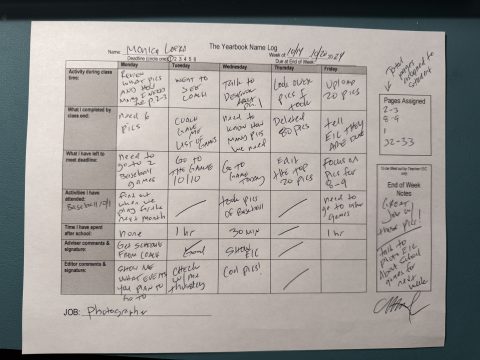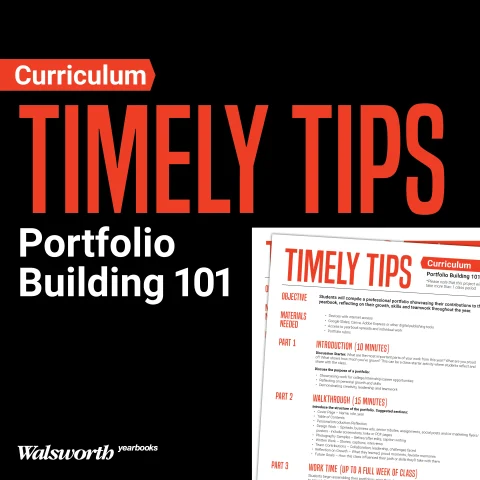Let’s face it: this time of year, we reps know our schools are juggling a lot – events, professional enrichment, and parent meetings, to name a few. Balancing that with yearbook deadlines and class organization can be daunting. As a yearbook rep, my goal is to help my advisers and staff feel excited and engaged.
The key to achieving that is creating a game plan that aligns with their own organization practices. There are hundreds of blank pages in need of compelling, relevant content. How you manage things can make or break your book, and it’s essential to establish a structure that works for your staff while setting basic expectations for both yourself and your fellow yearbookers. I’ve outlined simple strategies, tips and steps that will take you from chaos to clarity.
PUTTING IT INTO PRACTICE
Many people don’t know where to start. I’m often asked, “Monica, how do you juggle all of your accounts and other work responsibilities while still looking so good?” The truth is – genetics! But really, organization didn’t always come easily. When I became a yearbook rep, overseeing different schools, each with their own deadlines, adviser personalities and skills, I had to master the skill and quickly.
During the pandemic, I witnessed many advisers struggle even more than in a regular school year. I brainstormed ways to make their lives easier, inspired by the book Atomic Habits by James Clear. One key point I took from the book is that to manage a team effectively, you must understand how they process information.
Teams need to feel comfortable working together and supporting one another. Once that comfort is established, you can implement small changes that evolve into lasting habits. You can’t expect an unorganized student to submit a caption on time without daily tasks leading them there. Success requires diligence; once you set a standard, it becomes second nature.
CREATING NEW HABITS
To get to know your staff and foster daily habit changes, activities like icebreakers, warm-up games and weekly enrichment can help break down potential barriers, making it easier for students to bond.
Most advisers use icebreakers at the beginning of the year, but consider varying the activities to combat weekly monotony.
- To improve writing, try a daily prompt where you or the students submit questions and randomly draw one to respond to. This shouldn’t take more than five minutes, but repeated practice will enhance their writing skills.
- For photography, implement daily or weekly photo challenges.
- Focus on shutter speed one week, then have everyone submit their best shots by the end of the week, with top winners announced on Fridays.
- Save those winning images and showcase them at month’s end. Share them on your yearbook’s social media to give a sneak peek of the quality to expect on their yearbook.
Clear emphasizes the power of making tiny adjustments to behavior to foster lasting improvements. This is where creating a weekly goal sheet for your staff becomes crucial!
- Students need clear daily expectations to understand their final goal and hold themselves accountable, as well as adhere to editorial team expectations.
- If a student is disorganized or overwhelmed, breaking tasks down is key.
- For instance, rather than focusing on the entire 400-page book, break it down into what’s due next. How many pages are for mugs, senior ads, autograph pages, and the index? Once you do the math, you’ll see that the real content pages aren’t as daunting as they seem. If it’s your first year, look at last year’s work and ask your rep for guidance.
BREAK IT DOWN BY DEADLINES
Here are five easy steps to implement for deadline success.
- Identify which pages are due.
- Assign students to those pages.
- Clarify each student’s responsibility for their assigned pages.
- Are they collaborating on all tasks, or is each group focusing on specific roles like photography, writing or design?
- Set internal deadlines.
- Have your editor-in-chief (EIC) review pages to submit for quality and feedback within 24 to 48 hours of receiving.
- This allows time for revisions before the adviser’s final review. If the real deadline falls on Nov. 12, build margin by having the internal deadline Nov. 1.
- Give each student weekly tasks for each of their jobs (see the Yearbook Time Sheet and this Weekly Plan & Daily Log samples provided*).
- Have your editor-in-chief (EIC) review pages to submit for quality and feedback within 24 to 48 hours of receiving.
- This allows time for revisions before the adviser’s final review. If the real deadline falls on Nov. 12, build margin by having the internal deadline Nov. 1.
Once you’ve established this information, you can break it down by week. Use this Weekly Plan & Daily Log sheet as a template to get started or create your own to meet your unique needs.
EXTRA POINTERS ON YEARBOOK ORGANIZATION AND STRESS RELIEF
- Digital Tools. Utilize apps or platforms for task management (e.g., Trello, Notion) to keep everyone on the same page.
- Regular Check-Ins. Schedule weekly meetings to discuss progress, troubleshoot obstacles and celebrate small wins.
- Encourage Flexibility. Allow students to adjust their roles based on strengths and interests, which fosters engagement and ownership.
- Resource Sharing. Create a shared drive for templates, guides and resources that students can easily access.
- Positive Reinforcement. Recognize and reward effort, whether through shout-outs or small incentives.
- Mindfulness Practices. Introduce short mindfulness or relaxation exercises during meetings to help manage stress.
- Feedback Loops. Establish a system for giving and receiving feedback on work to promote improvement without overwhelming students.
- Example: Show a proofed spread with the entire class and critique.
WEEKLY BREAKDOWN PROCESS
How do I break down my week? Here is a breakdown of what I do:
 Daily Recap:
Daily Recap:
- At the end of each day, gather all my notes from various sources: voice notes, iPad, reminders, texts, voicemails, and emails.
- Consolidate everything into one document or sheet.
- Categorization:
- Sort my notes by priority. Identify urgent tasks, ongoing projects, and long-term goals.
- Create categories (e.g., “Immediate Tasks,” “By Weekend,” “Next Week”) to further organize my responsibilities.
- Checklist Creation
- Compile a comprehensive checklist from my categorized notes.
- Highlight the top four must-do tasks for the next 24 hours. This keeps my focus sharp and manageable.
- Weekly Overview
- Have a separate section in my planner for tasks due by the weekend and for items that can wait until the following Monday.
- This keeps me organized and ensures nothing slips through the cracks.
- Physical Checklists
- Use a paper planner. I use one from pinesman.com/product/one-day.
- I am on a screens all day – paper helps my brain rest from that.
ADDITIONAL TIPS
These additional tips are for the extra credit seekers who want even more organizational goodness.
- Time Block: Allocate specific times during your week to focus on certain tasks. This helps ensure that you’re dedicating uninterrupted time to your top priorities.
- Reflect and Adjust: At the end of each week, reflect on what worked well and what didn’ Adjust your methods accordingly for the next week.
- Daily Themes: Consider assigning themes to different days (e.g., “Meeting Mondays,” “Planning Tuesdays”) to give structure to your week.
- Break Down Larger Tasks: For bigger projects, break them into smaller, actionable steps and incorporate them into your daily checklists.
- Set Boundaries: Protect your time by setting boundaries for when you check emails or messages, helping you stay focused on your prioritized tasks.
- Incorporate Downtime: Schedule breaks or downtime to recharge, especially since you’re often on the go.
These strategies have done wonders in my own life and the lives of my advisers, but everyone has their own unique needs. The perfect solution may require a little trial and error, but the key is consistency. Stick with it even when it’s hard, and soon enough, new habits will form. Better still, each year, those habits become more ingrained in the DNA of your staff, leading to less stress and more clarity for your yearbook experience.
* Special thanks to Stephanie Perluss of West Covina High School for her sample time sheet and Kelly Tilson from Redlands East Valley High School for her version of weekly checklist.





